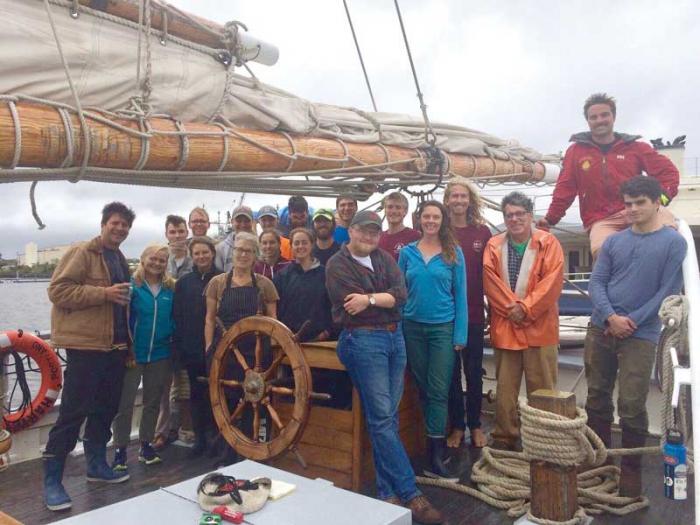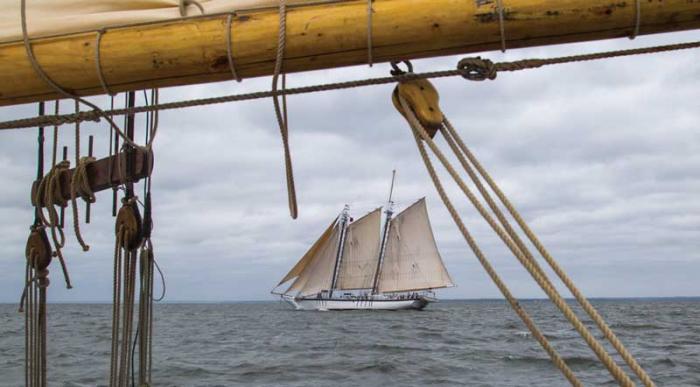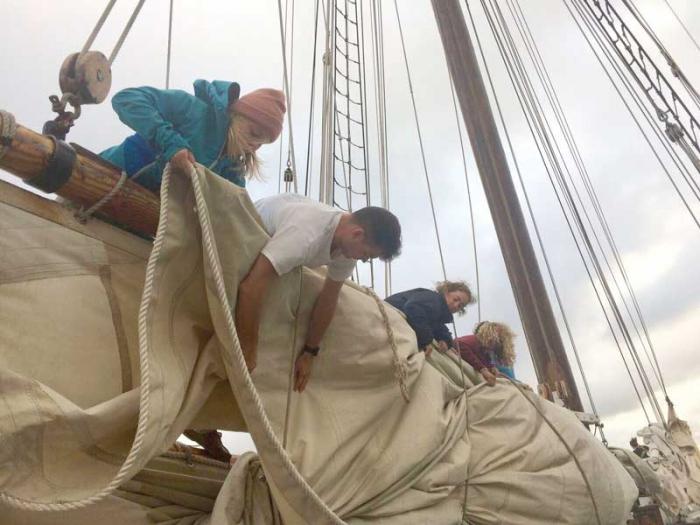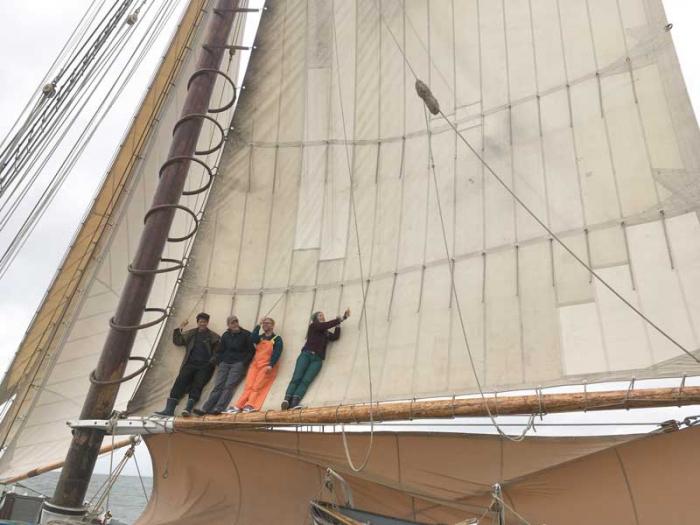“Was that thunder?” the Harvey Gamage’s engineer said as he scrambled on deck in the night. The bridle on the Gamage’s inner jib sheet had parted, and the noise from the luffing sails made a racket as we came to windward to lower the sail. The Great Chesapeake Bay Schooner Race was pushing Ocean Passages’ crew, gap semester students, and our ship, making us sharper, more agile sailors as we prepare to sail south to Cuba.

After dousing the sail, our deckhands, Meghan and Chelsea, were harnessed, climbing the netting past the bowsprit and onto the jibboom to contain the sail.
“Be careful! You’ll be hard to find,” ordered Captain Stephen Taylor, and then he directed our helmsman to return to course to keep up boat speed.
While we had plenty of power with our outer jib, staysail, fore, and main fully raised, second mate Calen immediately began re-rigging a replacement bridle for the inner jib sheet. This was our first race together, and our young crew was working seamlessly to manage sails, navigate, and make repairs underway.
Sailing past Lady Maryland, the crew and students were ecstatic, singing, “I need you more than anyone, darlin’.You know that I have from the start.” Like it or not, this had become our theme song during the trip south from Portland, ME. With a little bit of sail trim and a strong breeze, the schooner was in her prime.

The wind was blowing a steady 20 knots out of the east-northeast as the ship ran down the Bay on a port tack. For the race, the Harvey Gamage welcomed guest crew from St. Mary’s College of Maryland and SUNY Maritime College. These students joined our professional crew in tactics and strategy. The stars above lit the sky as our tacticians gathered amidships to examine various weather apps to predict when and if the east-northeast breeze would shift east. It was quite a scene watching sailors use smart phones on a traditionally rigged Gloucester fishing schooner. Perhaps sailors of yore would be aghast or impressed with this additional tool.
A few miles off Bethel Beach, VA, just to the west of the shipping channel, the Harvey Gamage bore down on schooner Tom Bombadill. We were approaching the smaller schooner swiftly as they flashed their spotlight on their sails to make sure that we saw them. We sailed by a few boat lengths apart. If we had not held our course, we would have become uncomfortably close to a freighter heading north to Baltimore. The wheel was heavy, and the 97 tonne schooner was eager to round up with each puff.
As the nav. team debated the next move, our educator, Claire, came on deck to announce that her father, who was following the race online from Oregon, saw that we were sailing at over 10 knots. The wind began to gust occasionally to 28 knots, which forced second mate Calen to hold the wheel hard to starboard to keep the ship from rounding up. After tweaking the sail trim to try to reduce weather helm, he woke Captain Taylor to consider a reef.

Tucking in a reef is not a quick task on a ship like the Harvey Gamage. It requires simultaneously lowering the peak and throat halyards on the heavy telephone pole-like spar on the gaff-rigged mainsail, while steering into the wind to calm things enough to work along the 44-foot-long main boom. All hands were called on deck to shorten sail. Fortunately, most everyone on the port side was already wide awake after being pitched back and forth from their bunks for the previous hour.
After setting the reef, the wind gradually settled down, which meant slower going for the rest of the race. Nonetheless, it was the prudent choice and made the ship significantly more maneuverable. Lady Maryland passed us while we shortened sail and kept between three and five miles of distance between us for the rest of the race. While this was disappointing, the reef was the right call in the night.
The Gamage crossed the finish line off of Thimble Shoals, VA, at 5:36 a.m. placing fourth in a fleet of seven. On our journey south to Cuba, this race gave our gap students and crew the opportunity to have the most exciting and challenging conditions since leaving Maine. It forced us to adapt to our environment and be flexible when working with each other. This ability to adapt is something that seasoned sailors know well. It’s a lesson that our students will take with them ashore in Cuba and in their journey through life.

Ocean Passages operates fall and spring semester voyages sailing to/from Cuba to Maine for gap semester students. Applications are now being accepted for sping 2018.
by Nathan Hesse




